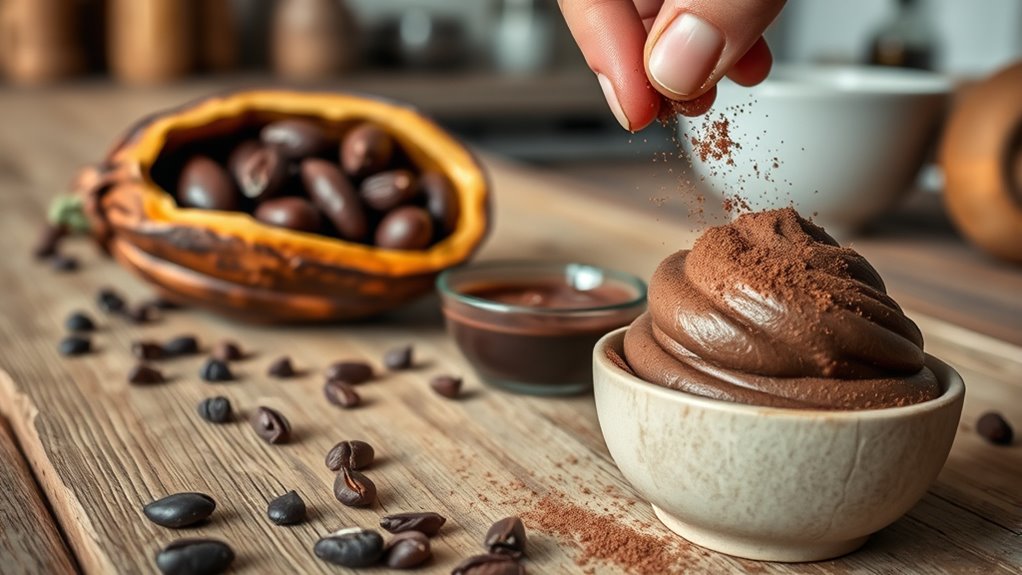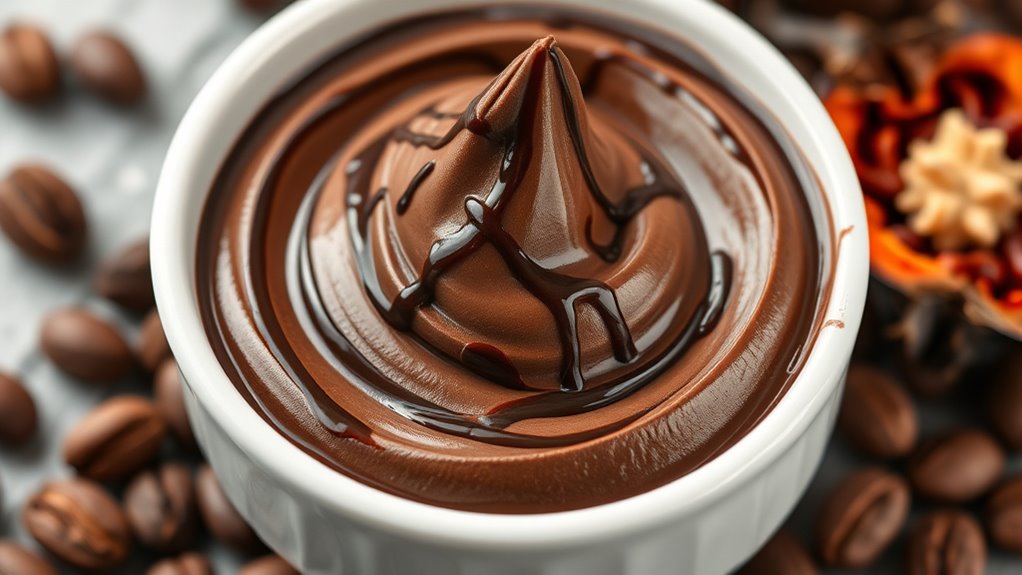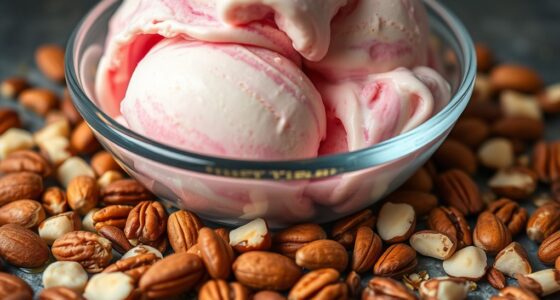To create rich chocolate gelato, begin with carefully harvested cacao beans that are fermented, dried, and roasted to develop complex flavors. The roasting process boosts the aroma and deepens the taste, while winnowing reveals nibs that are ground into a smooth paste called chocolate liquor. This base is refined through conching, where continuous mixing enhances its velvety texture. If you keep exploring, you’ll uncover how each step influences the delicious flavor in every spoonful.
Key Takeaways
- Cacao beans are harvested from ripe pods and undergo fermentation to develop complex flavors.
- Sun drying preserves the beans and influences final taste quality before roasting.
- Roasting enhances flavor and aroma, preparing beans for processing into chocolate.
- Beans are winnowed and ground into chocolate liquor, then conched to refine texture and flavor.
- The final chocolate’s flavor profile is shaped by cultivation, processing, and roasting, impacting the taste of gelato.

Chocolate begins its journey as a bitter cacao bean harvested from tropical cacao trees. The trees are carefully tended to, and once the pods ripen, skilled farmers harvest them by hand. Inside each pod are the cacao beans, surrounded by a sticky, sweet pulp. These beans are then fermented, a essential step that develops their complex flavors. The fermentation process can last several days and influences the final chocolate flavor profiles, imparting fruity, nutty, or even floral notes that set the foundation for delicious chocolate. Fermentation is a crucial stage that greatly impacts the final taste and aroma of the chocolate. After fermentation, the beans are dried under the sun, which helps preserve their quality and prepares them for roasting. Roasting is where the magic intensifies, as heat release deeper flavors and brings out the characteristic aroma that chocolate lovers cherish. During roasting, the beans are constantly monitored and rotated to guarantee even cooking, preventing bitter or burnt notes. Once roasted, you can smell the rich, inviting aroma of cacao, a proof to the depth of flavor already developing.
Cacao beans ferment for days, developing fruity, nutty, and floral flavors that form the foundation of delicious chocolate.
The next step involves winnowing, where the outer shells are removed, revealing the nibs—tiny pieces of cacao that are ground into a paste called chocolate liquor. This paste is then processed further, often involving conching, a technique that involves continuous mixing and aeration. Conching helps smooth out the texture and refine the flavor, turning raw cacao into a velvety base that can carry a spectrum of taste notes. Depending on the origin of the beans and the specific cacao cultivation practices, the resulting chocolate can have a wide range of flavor profiles — from fruity and bright to earthy and robust.
Understanding the nuances of cacao cultivation helps you appreciate how different regions produce beans with distinct characteristics. For example, beans from West Africa often have bright, fruity notes, while Latin American beans might offer complex, floral undertones. These flavor profiles are the backbone of what makes each chocolate unique. When you indulge in chocolate, whether dark, milk, or white, you’re experiencing an intricate blend of these flavors, shaped by the origin and processing of the cacao beans.
From these carefully cultivated and processed beans, the journey continues as the chocolate is blended, tempered, and finally transformed into the rich, smooth chocolate used for gelato. Your enjoyment of chocolate gelato is rooted in this intricate process, where each step influences the flavor profile you savor in every spoonful.
Frequently Asked Questions
How Does Cacao Bean Origin Affect Flavor Profiles?
You’ll notice that cacao bean origin markedly influences flavor profiles through varietal diversity and regional distinctions. Different regions and varietals develop unique tasting notes—some beans offer fruity, floral, or nutty flavors, while others have earthy or spicy tones. By understanding these regional flavor distinctions, you can appreciate how terroir and genetics shape the taste of chocolate, making each origin’s profile distinct and enriching your chocolate experience.
What Are the Environmental Impacts of Cacao Farming?
You should know that cacao farming impacts the environment through deforestation concerns and other issues. When you support sustainable farming practices, you help reduce these impacts, such as conserving biodiversity and preventing habitat loss. By choosing ethically sourced cacao, you actively contribute to protecting forests, promoting eco-friendly methods, and ensuring the long-term health of cacao-growing regions. Your choices can make a real difference in preserving the environment.
How Is Cacao Fermented to Develop Flavor?
Your cacao beans undergo fermentation techniques that are nothing short of magical, transforming them into flavor powerhouses. You start by placing beans in shallow boxes or bags, allowing natural yeasts and bacteria to work their magic. This process, which can take several days, develops complex flavors and reduces bitterness, turning raw cacao into a delectable treasure. Fermentation is the secret that unblocks the rich, nuanced taste you love in chocolate.
What Are the Health Benefits of Dark Chocolate?
You can enjoy dark chocolate for its health benefits, as it’s rich in nut antioxidant properties that help combat free radicals. Consuming moderate amounts may also boost your heart health by improving circulation and lowering blood pressure. Plus, its high flavonoid content supports overall cardiovascular function. Just remember to choose dark chocolate with high cacao content to maximize these benefits, and enjoy it as part of a balanced diet.
How Do Different Processing Methods Influence Chocolate Quality?
Processing methods shape chocolate quality like a sculptor molds clay. When you roast cacao beans, it develops rich flavors, enhancing aroma and depth. Conching techniques further refine texture, smoothing out harsh notes and improving mouthfeel. These steps are essential; high-quality processing preserves cocoa’s natural nuances, resulting in a superior chocolate experience. Skipping or rushing these methods can leave your chocolate feeling flat, like a song played on an out-of-tune instrument.
Conclusion
So, next time you indulge in that creamy chocolate gelato, remember the journey of the humble cacao bean. It’s a quiet symphony of transformation, whispering of warm sun, rich soils, and gentle hands. Each bite is like a secret shared between nature and craft, a delicate dance of flavors that softly cradle your senses. Savor it fully, knowing you’re tasting the tender art of a story that’s been lovingly spun from bean to bliss.









